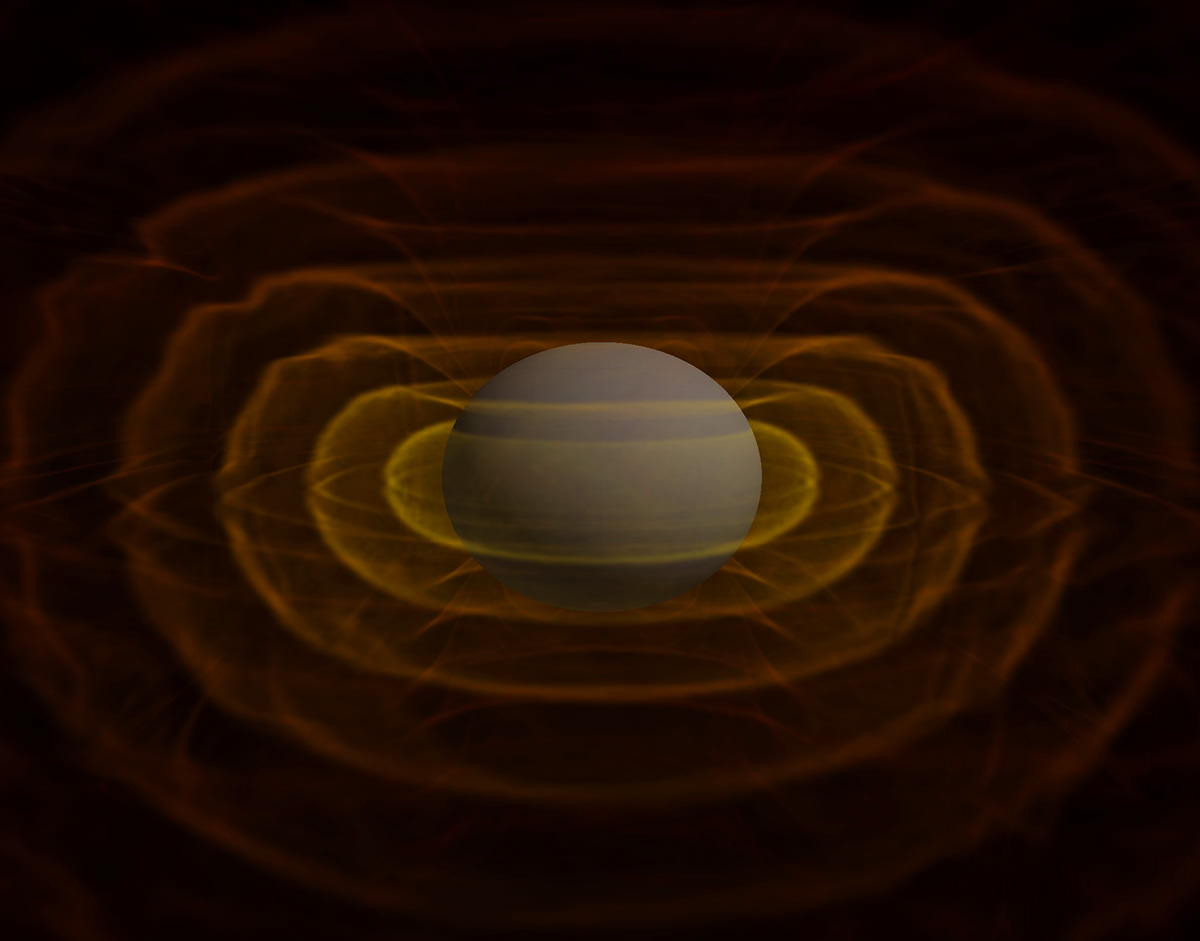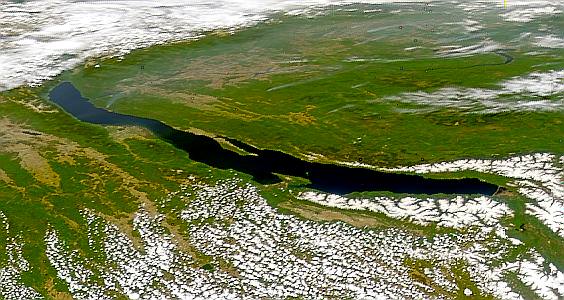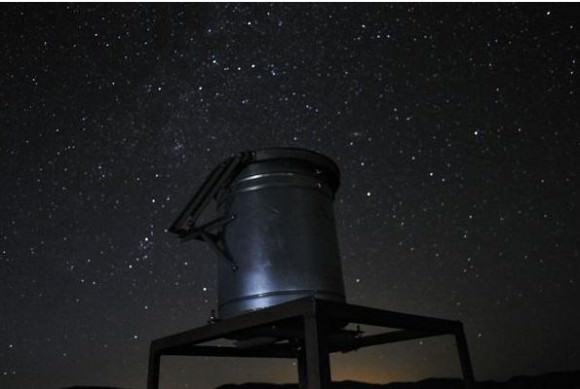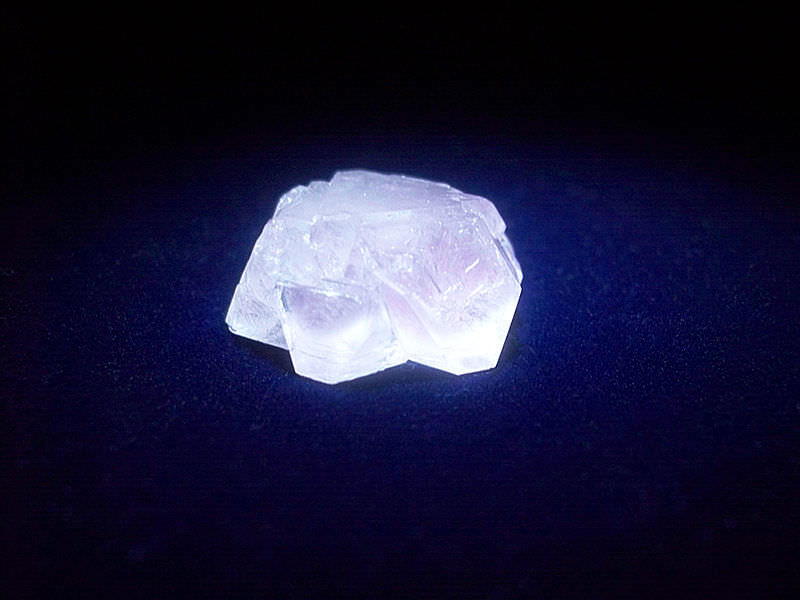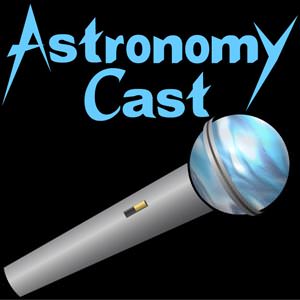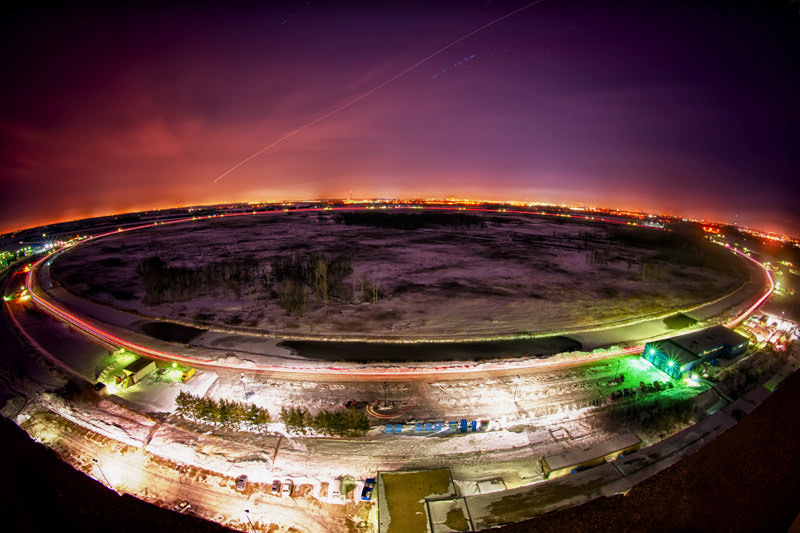Here’s another great video from the folks at Minute Physics. One of the most famous equations from one of the world’s most famous scientists is a bit more complicated than many people realize. E=mc² only describes objects with mass that aren’t moving. But what about massless particles – like light – that are moving? Check out the video for a quick explanation!
The 2012 Nobel Prize in Physics, Explained
This hot-off-the-press video from the science-explainer folks at Sixty Symbols does a great job of detailing the science of the work by Serge Haroche of France and American David Wineland, which won them 2012 Nobel Prize in physics today. Their experiments on quantum particles have already resulted in ultra-precise clocks and may one day help lead to computers that can work faster than those in use today.
The video also shows how expectations were that the prize might go to the teams at the Large Hadron Collier for the discovery of what they called a “Higgs-like boson” — a particle that resembles the long sought-after Higgs.
Continue reading “The 2012 Nobel Prize in Physics, Explained”
What Happens When Supermassive Black Holes Merge?
Frame from a simulation of the merger of two black holes and the resulting emission of gravitational radiation (NASA/C. Henze)
The short answer? You get one super-SUPERmassive black hole. The longer answer?
Well, watch the video below for an idea.
This animation, created with supercomputers at the University of Colorado, Boulder, show for the first time what happens to the magnetized gas clouds that surround supermassive black holes when two of them collide.
The simulation shows the magnetic fields intensifying as they contort and twist turbulently, at one point forming a towering vortex that extends high above the center of the accretion disk.
This funnel-like structure may be partly responsible for the jets that are sometimes seen erupting from actively feeding supermassive black holes.
The simulation was created to study what sort of “flash” might be made by the merging of such incredibly massive objects, so that astronomers hunting for evidence of gravitational waves — a phenomenon first proposed by Einstein in 1916 — will be able to better identify their potential source.
Read: Effects of Einstein’s Elusive Gravity Waves Observed
Gravitational waves are often described as “ripples” in the fabric of space-time, infinitesimal perturbations created by supermassive, rapidly rotating objects like orbiting black holes. Detecting them directly has proven to be a challenge but researchers expect that the technology will be available within several years’ time, and knowing how to spot colliding black holes will be the first step in identifying any gravitational waves that result from the impact.
In fact, it’s the gravitational waves that rob energy from the black holes’ orbits, causing them to spiral into each other in the first place.
“The black holes orbit each other and lose orbital energy by emitting strong gravitational waves, and this causes their orbits to shrink. The black holes spiral toward each other and eventually merge,” said astrophysicist John Baker, a research team member from NASA’s Goddard Space Flight Center. “We need gravitational waves to confirm that a black hole merger has occurred, but if we can understand the electromagnetic signatures from mergers well enough, perhaps we can search for candidate events even before we have a space-based gravitational wave observatory.”
The video below shows the expanding gravitational wave structure that would be expected to result from such a merger:
If ground-based telescopes can pinpoint the radio and x-ray flash created by the mergers, future space telescopes — like ESA’s eLISA/NGO — can then be used to try and detect the waves.
Read more on the NASA Goddard new release here.
First animation credit: NASA’s Goddard Space Flight Center/P. Cowperthwaite, Univ. of Maryland. Second animation: NASA/C. Henze.
Work Begins on the World’s Largest Cosmic Ray Observatory
Caption: Lake Baikal. Credit: SeaWiFS Project NASA/Goddard Space Flight Center and ORBIMAGE
Construction has just begun at the Tunka Valley near Lake Baikal, Siberia, Russia on an observatory that, once completed, will consist of an array of up to 1,000 detectors covering 100 square kilometres. Its size will allow scientists to investigate cosmic rays — the space radiation emitted from gamma rays and heavier nuclei — which are accelerated to energies higher than those achieved in the Large Hadron Collider. With the new observatory, called HiSCORE (Hundred Square-km Cosmic ORigin Explorer), scientists hope to solve the mystery of the origins of cosmic rays, and perhaps probe dark matter too
It was a hundred years ago that Austrian-American physicist Victor Hess first discovered that radiation was penetrating Earth’s atmosphere from outer space. The problem has been to track down their origin, as cosmic rays consist of charged particles and are therefore deflected in interstellar and intergalactic magnetic fields. The use of simple, inexpensive detector stations, placed several hundred meters apart, makes it possible to instrument a huge area, allowing scientists to investigate cosmic rays within an energy range from 100 TeV up to at least 1 EeV.
Cherenkov detector in front of the starry sky. Image: Tunka Collaboration
Cosmic rays cannot penetrate our atmosphere but each detector can observe the radiation created when cosmic rays hit the Earth’s upper atmosphere, causing a shower of secondary particles that travel faster than the speed of light in air, producing Cherenkov radiation in the process. This light is weak, but can be detected on the surface of the earth with sensitive instruments like HiSCORE’s photomultiplier tubes.
Cherenkov radiation can be used to determine the source and intensity of cosmic rays as well as to investigate the properties of high-energy astronomical objects that emit gamma rays like supernova remnants and blazars. The wide field of view also allows HiSCORE to monitor extended gamma ray emitting structures such as molecular gas clouds, dense regions or large scale structures such as star forming regions or the galactic plane.
HiSCORE can also be used for testing theories about Dark Matter. A strong absorption feature is expected around 100 TeV. Examination can give information about the absorption of gamma rays in the interstellar photon fields and the CMB. If the absorption is less than expected, this might indicate the presence of hidden photons or axions. Also, the decay of heavy supersymmetric particles might be detectable by HiSCORE. The data will improve as the facility grows over the years. By 2013-14 the area will be around one square kilometre, and over 10 square kilometres by 2016.
HiSCORE is a joint project between the Institute for Nuclear Research of the Russian Academy of Sciences in Moscow, Irkutsk State University in Siberia and Lomonosov Moscow State University – as well as DESY, the University of Hamburg and the Karlsruhe Institute of Technology in Germany. HiSCORE also hopes to collaborate with the Pierre Auger observatory in Argentina.
Find out more about HiSCORE at the project’s website
A Space-Time Crystal to Outlive the Universe
Caption: Selfmade Alum Crystal. Weight 5.01g Source: JanDerChemiker via wikimedia commons
The second law of thermodynamics states that all isolated systems head towards entropy. Our universe will one day reach a state where all energy is evenly distributed and can no longer sustain motion or life. A group of physicists have speculated that a device called a ‘space-time crystal’ could theoretically continue to work as a computer even after the heat death of the universe. Trouble was that they had no idea how to build a space-time crystal, until now.
Crystals are made up of repeating patterns of atoms or molecules, they are symmetrical in space and in their lowest energy state. They are the result of removing all the energy from a system (like ice crystals forming when heat is taken away) Nobel-prize winning physicist Frank Wilczek at the Massachusetts Institute of Technology speculated that the symmetry of such crystalline structures could exist in the fourth dimension of time as well as in space. The atoms in a time crystal would constantly rotate and return to their original location and, being in their lowest possible energy state they would continue to rotate even after the universe has succumbed to entropy. Such a repeating pattern of motion usually requires energy but now a group of scientists at the University of Michigan in Ann Arbor and Tsinghua University in Beijing, led by Tongcang Li at the University of California, Berkeley think they have worked out how to create such a crystal in its lowest energy state that shows this repeating pattern, or periodic structure, in both space and time, a space-time crystal.
They propose constructing an ion trap, which holds charged particles in place using an electric field. The ions naturally repel each other due to Coulomb repulsion, forming a ring-shaped crystal which can be made to rotate by applying a weak static magnetic field. If you then remove the electric field, the ions will continue rotating by themselves. This does not violate any laws of physics, it isn’t a perpetual motion machine as no energy can be taken out of the system, it can’t do any work even though it is moving. The main challenge to building the crystal will be the need to bring the temperatures close to absolute zero.
Space-time crystals’ periodicity makes them natural clocks. Wilczek suggests building a computer from a working time crystal, with different rotational states standing in for the 0s and 1s of a conventional computer. Such a computer would be able to survive the eventual heat death of the Universe. There is just one small snag, however, as Tongcang Li admits “we focus on a space-time crystal that can be created in a laboratory, so you need to figure out a method to make a laboratory that can survive in the heat-death of the universe.”
Read more here
Astronomy Cast Ep. 269: Mass

Last week we talked about energy, and this week we’ll talk about mass. And here’s the crazy thing. Mass, matter, the stuff that the Universe is made of, is the same thing as energy. They’re connected through Einstein’s famous formula – E=mc2. But what is mass, how do we measure it, and how does it become energy, and vice versa.
Click here to download the episode.
Or subscribe to: astronomycast.com/podcast.xml with your podcatching software.
“Mass” on the Astronomy Cast website, with shownotes and transcript.
And the podcast is also available as a video, as Fraser and Pamela now record Astronomy Cast as part of a Google+ Hangout:
Podcast: Energy

Our entire civilization depends on energy: getting it, converting it, burning it, and conserving it. But how do physicists think about energy? How do they measure and quantify it. And what is energy’s special relationship with mass?
Click here to download the episode.
Or subscribe to: astronomycast.com/podcast.xml with your podcatching software.
“Energy” on the Astronomy Cast website.
And the podcast is also available as a video, as Fraser and Pamela now record Astronomy Cast as part of a Google+ Hangout:
Continue reading “Podcast: Energy”
The Higgs Boson in One Minute… or Two…
If you’re still scratching your head, trying to figure out all the Higgs Boson news, the great folks from MinutePhysics have put together a new video to explain it all. However, since this is all a little complicated, it’s going to take more than one minute. Parts 2 and 3 are on their way!
What’s a Higgs Boson, Anyway?
With the science world all abuzz in anticipation of tomorrow’s official announcement from CERN in regards to its hunt for the Higgs, some of you may be wondering, “what’s a Higgs?” And for that matter, what’s a boson?
The video above, released a couple of months ago by the talented Jorge Cham at PHDcomics, gives a entertaining run-down of subatomic particles, how they interact and how, if it exists — which, by now, many are sure it does — the Higgs relates to them.
It’s the 7-minutes course in particle physics you’ll wish you had taken in college (unless you’re a particle physicist in which case… well, you’d still probably have enjoyed it.)
Credit: PHDcomics.com
Tevatron Targets Higgs Mass
Today, researchers from Fermilab announced they have zeroed in further on the mass of the Higgs boson, the controversially-called “God particle”* that is thought to be the key to all mass in the Universe. This news comes just two days before a highly-anticipated announcement by CERN during the ICHEP physics conference in Melbourne, Australia (which is expected by many to confirm actual proof of the Higgs.)
Even after analyzing the data from 500 trillion collisions produced over the past decade at Fermilab’s Tevatron particle collider the Higgs particle has not been identified directly. But a narrower range for its mass has been established with some certainty: according to the research the Higgs, if it exists, has a mass between 115 and 135 GeV/c2.
“Our data strongly point toward the existence of the Higgs boson, but it will take results from the experiments at the Large Hadron Collider in Europe to establish a discovery,” said Fermilab’s Rob Roser, cospokesperson for the CDF experiment at DOE’s Fermi National Accelerator Laboratory.
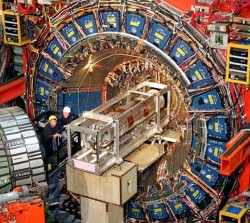 Researchers hunt for the Higgs by looking for particles that it breaks down into. With the Large Hadron Collider at CERN, scientists look for energetic photons, while at Fermilab CDF and DZero collaborators have been searching for bottom quarks. Both are viable results expected from the decay of a Higgs particle, “just as a vending machine might return the same amount of change using different combinations of coins.”
Researchers hunt for the Higgs by looking for particles that it breaks down into. With the Large Hadron Collider at CERN, scientists look for energetic photons, while at Fermilab CDF and DZero collaborators have been searching for bottom quarks. Both are viable results expected from the decay of a Higgs particle, “just as a vending machine might return the same amount of change using different combinations of coins.”
Fermilab’s results have a statistical significance of 2.9 sigma, meaning that there’s a 1-in-550 chance that the data was the result of something else entirely. While a 5-sigma significance is required for an official “discovery”, these findings show that the Higgs is running out of places to hide.
“We have developed sophisticated simulation and analysis programs to identify Higgs-like patterns,” said Luciano Ristori, co-spokesperson of the CDF experiment. “Still, it is easier to look for a friend’s face in a sports stadium filled with 100,000 people than to search for a Higgs-like event among trillions of collisions.”
“We achieved a critical step in the search for the Higgs boson. Nobody expected the Tevatron to get this far when it was built in the 1980s.”
– Dmitri Denisov, DZero cospokesperson and physicist at Fermilab
Nearly 50 years since it was proposed, physicists may now be on the edge of exposing this elusive and essential ingredient of… well, everything.
See the Fermilab press release here.
Read Fermilab’s FAQs on the Higgs boson
Top image: The Tevatron typically produced about 10 million proton-antiproton collisions per second. Each collision produced hundreds of particles. The CDF and DZero experiments recorded about 200 collisions per second for further analysis. Sub-image: The three-story, 6,000-ton CDF detector recorded snapshots of the particles that emerge when protons and antiprotons collide.(Fermilab)
*And why is it often called the God particle? Because of this book.

